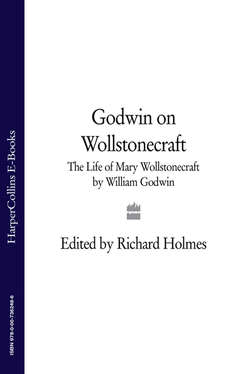Читать книгу Godwin on Wollstonecraft: The Life of Mary Wollstonecraft by William Godwin - William Godwin - Страница 9
6
ОглавлениеPerhaps it was there from the beginning. A year after the publication of the Memoirs, the poet and novelist Mary Robinson released her Letter to the Women of England on the Injustice of Mental Subordination (1799). Originally a Shakespearean actress (‘Perdita’ Robinson) and mistress to the teenage Prince of Wales, Robinson’s later literary work in the 1790s brought her the friendship of both Godwin and Coleridge. Her Letter initially appeared under the pseudonym ‘Anne Randall’, but it was published by Longman, the biggest bookseller in London, and received wide circulation.
Robinson refers openly and admiringly to The Rights of Woman and salutes Wollstonecraft as ‘an illustrious British female…to whose genius Posterity will render justice’. In a militant footnote she describes herself proudly as ‘avowedly of the same school’ as Mary Wollstonecraft, and prophetically foresees her embattled life as having initiated a long campaign for women’s rights which would stretch far into the 19th century. ‘For it requires a legion of Wollstonecrafts to undermine the poisons of prejudice and malevolence.’
One of Mary Robinson’s most striking conclusions at the end of her hundred page Letter is that Wollstonecraft’s commitment to female education (emphasized by Godwin) lead logically to the idea of women going to university. ‘Had fortune enabled me, I would build a UNIVERSITY FOR WOMEN.’ Only then would women truly be equal.
In the year after Wollstonecraft’s death, a new biographical series entitled Public Characters (dedicated to the King) was launched, and would continue for the next decade. It carried some 30 ‘living biographies’ per annual issue, and featured such figures as Nelson, Wilberforce, Humphry Davy, Sheridan and Castlereagh. Volume 2 (1799) included a twenty-page ‘contemporary biography’ of Godwin. It was warmly favourable, and gave a sympathetic four page account of his marriage to Mary Wollstonecraft (‘that most celebrated and most injured woman’), and unstinting praise for both editions of the Memoirs. It concluded as follows, in a remarkable passage that has never been reprinted since.
It was in January 1798 that Mr Godwin published his Memoirs of the Life of Mrs Godwin. In May of the same year a second edition of that work appeared. A painful choice seems to present itself to every ingenuous person who composes Memoirs of himself or of any one so nearly connected with himself as in the present instance. He must either express himself with disadvantage to the illiberal and malicious temper that exists in the world, or violate the honor and integrity of his feelings.
Yet that the heart should be known in all its windings, is an object of infinite importance to him who would benefit the human race. Mr Godwin did not prefer a cowardly silence, nor treachery to the public, having chosen to write. Perhaps such works as the Memoirs of Mrs Godwin’s Life, and Rousseau’s Confessions, will ever disgrace their writers with the meaner spirits of the world. But then it is to be remembered, that this herd neither confers, nor can take away, fame.’
Most moving of all, the revolutionary influence of Mary Wollstonecraft’s life continued through the next generation of her own family, the family she never knew. It was a powerful and unsettling example. Her love-child, Fanny Imlay, eventually committed suicide. But when her daughter Mary Godwin and Shelley eloped to France in 1814, they carried the Posthumous Works and the Memoirs with them in their tiny travelling trunk, and read them during their first nights in Paris. Shelley’s poem The Revolt of Islam (1817) contained a heroic portrait of her. His triumphant chorus from his late verse drama Hellas (1821), written about the Greek War of Independence, drew on Godwin’s memorable snake imagery of hope and revival.
The world’s great age begins anew,
The golden years return,
The earth does like a snake renew
Her winter weeds outworn…
Mary Shelley’s entire literary career was inspired by her mother’s example, and especially perhaps her desire to write novels of ideas. Both Frankenstein (1818), and The Last Man (1826) can be seen as part of the complex Wollstonecraft inheritance. After her father Godwin’s death, she always intended to write a combined biography of both her daring literary parents.
A few scattered manuscript notes alone have survived, probably dating from the early 1840s. This is what the subdued, widowed, middle-aged Victorian Mary Shelley wrote about her outrageous mother Mary Wollstonecraft. ‘Her genius was undeniable. She had been bred in the hard school of adversity, and having experienced the sorrows entailed on the poor and oppressed, an earnest desire was kindled within her to diminish these sorrows. Her sound understanding, her intrepidity, her sensibility and eager sympathy, stamped all her writings with force and truth, and endorsed them with a tender charm that enchants while it enlightens. She was one whom all loved, who had ever seen her.’
But of course Mary had never seen her mother. She only knew and loved her through her own writings and her father’s intrepid and controversial Memoirs. Such is the dangerous, enduring power of biography.
The text of the Memoirs reprinted here is that of Godwin’s first, uncorrected edition of January 1798, apart from a few spellings that have been modernized. The three passages that Godwin substantially re-wrote for the second edition – concerning Henry Fuseli (Chapter 6), Wollstonecraft’s suicide attempt (Chapter 8), and his summary of Wollstonecraft’s character (Chapter 10) – are given in the Appendix.
